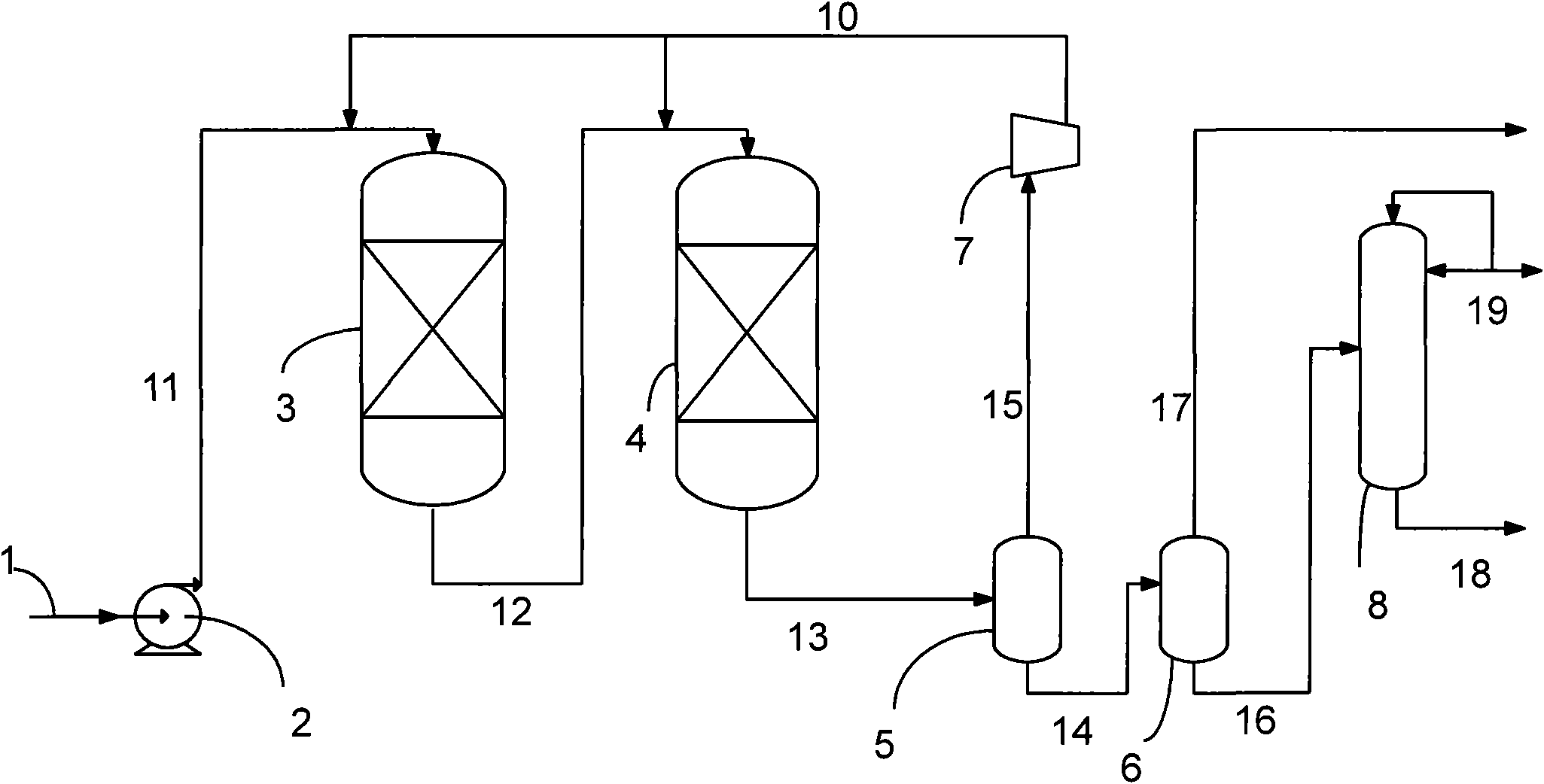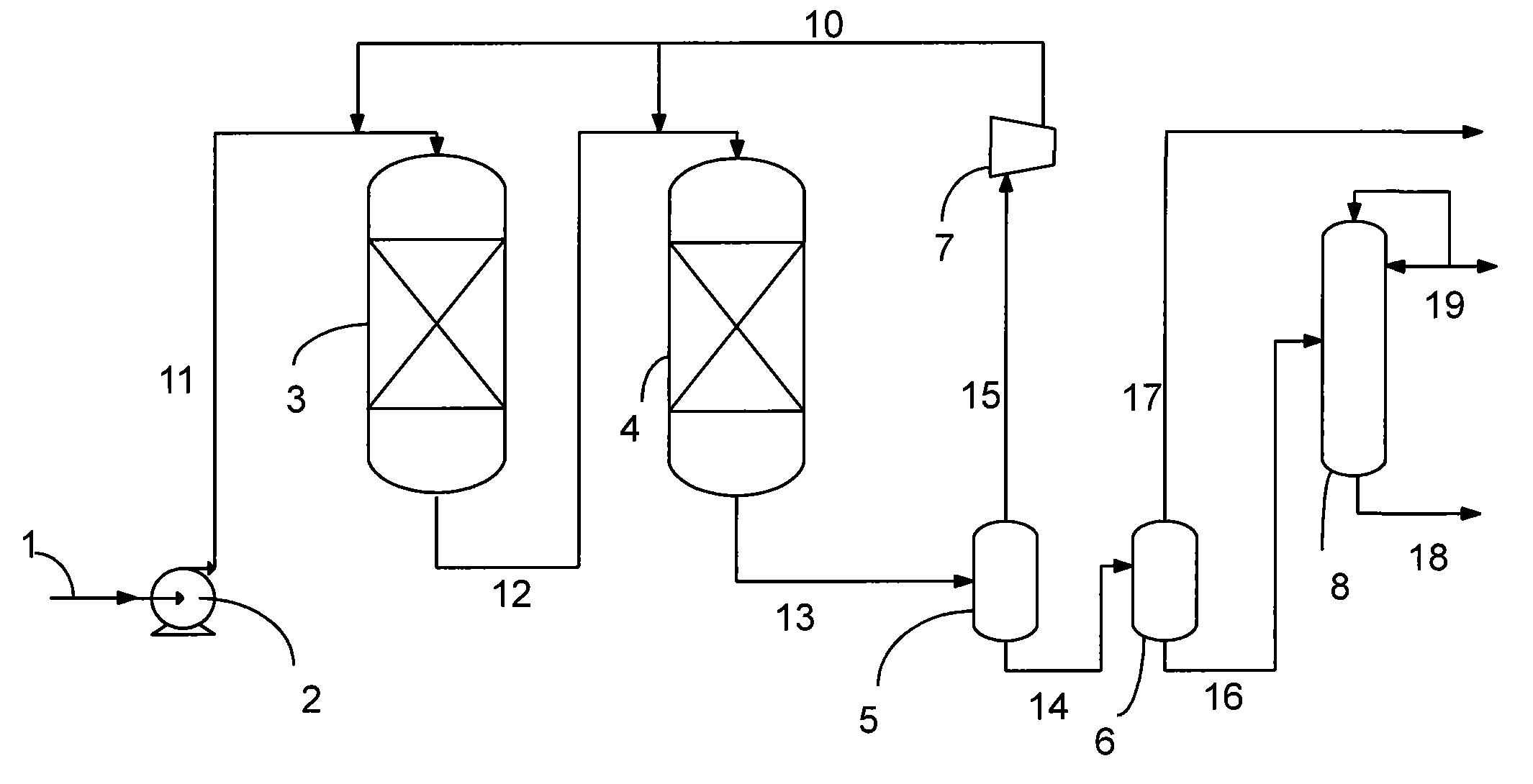Method for producing high-octane petrol by inferior diesel
A technology for high-octane gasoline and low-quality diesel, which is used in hydrocarbon oil cracking, petroleum industry, processing of hydrocarbon oil, etc. The effect of low cost, easy operation and simple installation process
- Summary
- Abstract
- Description
- Claims
- Application Information
AI Technical Summary
Problems solved by technology
Method used
Image
Examples
Embodiment 1
[0026] The raw material oil D enters the hydrogenation reactor together with hydrogen, and in turn reacts with the hydrorefining catalyst B in the first reaction zone and the hydrocracking catalyst C in the second reaction zone, and the effluent after the reaction enters the high pressure without any intermediate separation. Separator, low-pressure separator, after cooling and separation, the hydrogen-rich gas is recycled, and the liquid product enters the fractionation system and is separated into gasoline fraction and diesel fraction. The saturation depth of aromatic hydrocarbons in the reaction zone, that is, compared with the diesel feedstock oil, the saturation rate of bicyclic and more than bicyclic aromatic hydrocarbons in the reaction effluent of the first reaction zone is 69.7%, and is based on the reaction effluent of the first reaction zone. Based on the liquid component, the monocyclic aromatic hydrocarbon content was 51.6% by mass. The reaction conditions are show...
Embodiment 2
[0029] The feed oil D enters the hydrogenation reactor together with hydrogen, and in turn reacts with the hydrorefining catalyst A in the first reaction zone and the hydrocracking catalyst C in the second reaction zone, and the reacted effluent enters the high pressure without any intermediate separation. Separator, low-pressure separator, after cooling and separation, the hydrogen-rich gas is recycled, and the liquid product enters the fractionation system and is separated into gasoline fraction and diesel fraction. The loading volume ratio of hydrotreating catalyst and hydrocracking catalyst is 1:1. The saturation depth of aromatic hydrocarbons in the reaction zone, that is, compared with the diesel feedstock oil, the saturation rate of bicyclic and more than bicyclic aromatic hydrocarbons in the reaction effluent of the first reaction zone is 54.9%, and is based on the reaction effluent of the first reaction zone. Based on the liquid component, the monocyclic aromatic hydro...
Embodiment 3
[0032] The raw material oil E enters the hydrogenation reactor together with hydrogen, and in turn reacts with the hydrorefining catalyst A in the first reaction zone and the hydrocracking catalyst C in the second reaction zone, and the effluent after the reaction enters the high pressure without any intermediate separation. Separator, low pressure separator, after cooling and separation, the hydrogen-rich gas is recycled, and the liquid product enters the fractionation system and is separated into gasoline fraction and diesel fraction. The saturation depth of aromatic hydrocarbons in the reaction zone, that is, compared with the diesel feedstock oil, the saturation rate of bicyclic and more than bicyclic aromatic hydrocarbons in the reaction effluent of the first reaction zone is 55.0%, and is based on the reaction effluent of the first reaction zone. Based on the liquid component, the monocyclic aromatic hydrocarbon content was 51.8% by mass. The reaction conditions are show...
PUM
 Login to View More
Login to View More Abstract
Description
Claims
Application Information
 Login to View More
Login to View More - R&D
- Intellectual Property
- Life Sciences
- Materials
- Tech Scout
- Unparalleled Data Quality
- Higher Quality Content
- 60% Fewer Hallucinations
Browse by: Latest US Patents, China's latest patents, Technical Efficacy Thesaurus, Application Domain, Technology Topic, Popular Technical Reports.
© 2025 PatSnap. All rights reserved.Legal|Privacy policy|Modern Slavery Act Transparency Statement|Sitemap|About US| Contact US: help@patsnap.com


